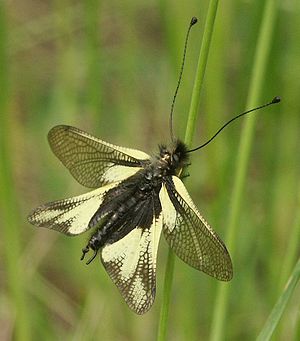Dragonfly butterfly-like
| Dragonfly butterfly-like | ||||||||||||
|---|---|---|---|---|---|---|---|---|---|---|---|---|

Dragonfly butterfly ( Libelloides coccajus ) |
||||||||||||
| Systematics | ||||||||||||
|
||||||||||||
| Scientific name | ||||||||||||
| Libelloides coccajus | ||||||||||||
| Denis & Schiffermüller , 1758 |
The Dragonfly owlfly ( Libelloides coccajus ) is a lacewings (Neuroptera) from the family of owlfly (Ascalaphidae).
description
The animals reach a wingspan of 42 to 55 millimeters. Their front wings are lemon yellow on the front edge up to the tip and around the base of the wings. White-colored specimens are also less common. There is a black spot between the two yellow spots. The rest of the wing is transparent, only the network of veins is jet black. The hind wings are black at the base and parts of the margin, otherwise lemon yellow. The body is black. The long black antennae are thickened at the ends. The males can be recognized by their curved abdominal forceps ( cerci ).
.
Way of life
The adults have a life expectancy of four to five weeks. After hatching in early to mid-May, on dry and sunny days from May to July, they fly in hovering flight close to the vegetation or very high to hunt small flying insects , while keeping a relatively large escape distance . The UV-sensitive compound eyes support the recognition of their prey in sunshine. When the sun disappears, even if only for a short time, they attach themselves to a stalk with their biting mouthparts and remain inactive during the shading period. In doing so, they spread their wings towards the sun, so that the wings of all dragonfly butterfly-like are aligned parallel. In this position they are no longer jumpy, they do not fly up even if the stalk is carefully broken off and can starve to death if it is still cloudy.
The egg-laying takes place mostly in the upper slope area of open ground points. The female probably only lays a single clutch of 30–65 eggs on a free-standing stem, which is additionally heated by reflection from the ground, which accelerates the drying of the eggs after rain. Nevertheless, this stalk is chosen so that it is mostly shaded and only stands on a slightly inclined surface. This space can be so rare and attractive that one stalk can be used for several clutches. If the clutch is close to the ground because the stalk is bent, the eggs can barely reach maturity, then they are captured by soil animals or dry too slowly after rain. The hatching time varies depending on the drought, it is usually four weeks, can be considerably shorter or over 40 days.
The larval development on the ground will probably take two years.
Occurrence
The animals are rarely found in Central Europe . They are found in the southwest on dry, warm slopes with open vegetation, occasionally also in the area of scree fields. They do not occur in northern Europe.
literature
- Michael Chinery: Parey's Book of Insects. A field guide of European insects. Translated from the English by Irmgard Jung. Franckh-Kosmos, Stuttgart 2004, ISBN 3-440-09969-5 .
- URANIA animal kingdom: Volume 3: Insects. , Leipzig, Jena, Berlin 1994, p. 229 ff., 239 ruf
- Werner Wolf: The dragonfly butterfly Libelloides coccajus in the Bavarian Taubertal - habitat, requirements, development data. In: BayLfU / BWLfU / ANL , 2005, pp. 61–66, PDF .
Individual evidence
- ↑ a b c d e Heiko Bellmann, Der Neue Kosmos Insektenführer , p. 134, Franckh-Kosmos Verlags-GmbH & Co, Stuttgart 1999, ISBN 3-440-07682-2 .
- ↑ a b c d e f g h i j Werner Wolf: The dragonfly butterfly Libelloides coccajus in the Bavarian Taubertal - habitat, requirements, development data. In: BayLfU / BWLfU / ANL , 2005, pp. 61–66, PDF .
- ^ Karl Kral: Ultraviolet vision in European owlflies (Neuroptera: Ascalaphidae): a critical review. In: Eur. J. Entomol. Volume 99, 2002, pp. 1-4, PDF .
